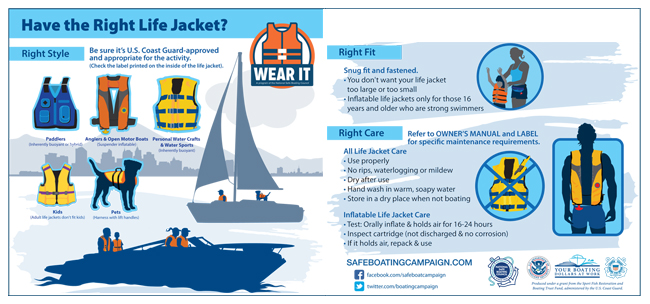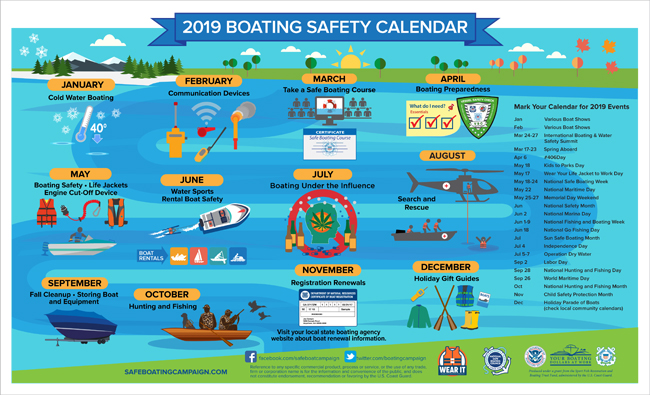
Credit: National Safe Boating Council.
Contact:
Dave White, New York Sea Grant, Recreation and Tourism Specialist, P: 315-312- 3042, E: dgw9@cornell.edu
Oswego, NY, May 20, 2019 - Every year the New York Sea Grant (NYSG) Discover Clean and Safe Boating educational vessel is equipped with all the gear required and recommended for boating on New York waters.
Because boating is a year ’round pursuit in New York, NYSG Coastal Recreation and Tourism Specialist Dave White is continually educating people about how to properly select a life vest and when they are legally required to wear it.
“People are naturally more aware of the need to wear a life vest through the traditional boating season, but in New York State anyone who is in a boat of less than 21 feet length is required to have a life vest on from November 1 to April 30,” White says.
He notes that as soon as ice is out in the spring some hardy souls are launching canoes, kayaks and small boats, without proper safety measures in place and with potentially fatal results.
“It is easy to get excited about boating when the air temperature is warming in the spring, but it is critical to remember that the water temperature remains a threat for hypothermia that can quickly debilitate anyone who falls in,” says White, a New York State Boating Educator of the Year.
White often demonstrates float coats and float suits that can help keep alive early spring boaters, fall duck hunters, and ice anglers who find themselves in trouble until rescuers can reach them. For the traditional boating season, he explains the various types of Coast Guard-approved life vests, which include inflatable and fanny pack options.
“Select bright colors for higher visibility of any life saving device and attach a whistle directly to the suit so you can signal for help,” White advises.
Having a proper, easily-heard sounding device is a key educational point for White.
“You need a signaling device that works and will get people’s attention. For example, I can hardly hear the horn on my vintage 21-foot boat because it is so weak, so I also carry an air horn and whistle onboard,” White says.
White also suggests posting a placard onboard as a handy reference to identify the different signals that can be made with a boat horn or, for non-motorized boaters, a whistle.
“The most important signal to know is five short blasts on a whistle, or horn, to communicate an emergency. Other combinations may let people know you are moving away from the dock, backing up, or about to pass to port or starboard,” White explains.
The Great Lakes’ internationally-shared waters also makes it imperative that boaters know the rules and regulations for boating both in the U.S. and Canadian waters.
“Boaters need to know the rules and the differences in how the two countries address boating matters. For example, the Canadians have a zero tolerance law for any sanitation discharge, even from a Marine Sanitation Device or MSD. If you are in Canadian waters, your MSD must be locked down to prevent any overboard discharge,” White explains.
White encourages the use of online resources posted by such sources as the U.S. and Canadian, New York and provincial governments to learn cross-border boating requirements for personal identification as well as navigation.
Familiarizing yourself with navigation law not only safeguards you and your passengers and informs you about how to comply with vessel safety inspections, it can also provide for some interesting reading and. For example, did you know New York State Navigation Law restricts how much noise can be generated by a pleasure vessel, its engine, muffler, etc.?
Other quick tips from New York Sea Grant’s Discover Clean and Safe Boating campaign include:
• Take the U.S. Coast Guard Auxiliary (USCGA) Suddenly in Command training so non-boaters onboard are prepared to calmly take control of the boat and signal for help in the event of an emergency on the water.
• In New York State, anyone born on or after May 1, 1996, must pass a boating safety course approved by the State and carry that certification on board to operate a boat alone on New York waters. Check to see what age and certification is required for boating in other states.
• Check to see if your local America’s Boating Club: U.S. Power Squadron Chapter offers training on a Boating Skills Virtual Trainer that lets you try driving a Boston Whaler on a 4-mile lake with varying levels of difficulty and wind and water conditions. Users learn how to leave and return to the dock, turn, moor, make an emergency stop, and more
• For safety, know how to properly ignite a flare.
• Check the expiration dates on flares and status of fire extinguishers onboard; replace as needed, and store in a dry compartment.
• For canoes and kayaks, the New York State Parks Marine Services Bureau offers If Found stickers that help locate a lost vessel and reflective Safe ‘n Sight decals for oars and paddles to increase the visibility in boats low on the water.
• Use a fuel nozzle bib or collar, and a bilge sock. Both are inexpensive ways to keep your boating waters clean.
• Don’t forget the family pet. Life jackets are available with a handle for hauling overboard pets out of the water.
• To slow the spread of aquatic invasive species, practice Clean, Drain, Dry with boats of all types and trailers. Check those nooks and crannies where marine debris collects and be sure to wash them clean before you enter or leave for any new water body.
The New York Sea Grant’s Discover Clean and Safe Boating campaign is a partnership with the Boating Industries Association of Upstate New York, marine dealers, the U.S. Coast Guard Auxiliary, New York State Parks Marine Services Bureau, and boat show managers, who have supplied boats, gear, personnel and space for the educational exhibit since 2008. The campaign has educated more than one million boaters since its inception.
White and the campaign have received a BoatUS Foundation for Boating Safety and Clean Water Environmental Leadership Commendation, a U.S. Coast Guard Auxiliary Wear It! Award, and National Association of Boating Law Administrators Northern States Boating Education of the Year honors.
 Credit: National Safe Boating Council.
Credit: National Safe Boating Council.
For more information, check out Dave White's NYSG "Boating and Marine Trades" content,
www.nyseagrant.org/marina. He also has information on Great Lakes shipwrecks at
www.nyseagrant.org/shipwreck.
There's also a
NYS Parks Navigation & Safety Quick Reference Guide.
And for more on National Safe Boating Week, a campaign that runs from May 18-24 this year, see the topical resources provided by Sea Grant's parent organization, the National Oceanic and Atmospheric Administration, and its National Weather Service at
www.weather.gov/safety/safeboating-week.
More Info: New York Sea Grant
New York Sea Grant (NYSG), a cooperative program of Cornell University
and the State University of New York (SUNY), is one of 33 university-based
programs under the National Oceanic and Atmospheric Administration’s
National Sea Grant College Program.
Since 1971, NYSG has represented a statewide network of integrated
research, education and extension services promoting coastal community
economic vitality, environmental sustainability and citizen awareness
and understanding about the State’s marine and Great Lakes resources.
Through NYSG’s efforts, the combined talents of university scientists
and extension specialists help develop and transfer science-based
information to many coastal user groups—businesses and industries,
federal, state and local government decision-makers and agency managers,
educators, the media and the interested public.
The program maintains Great Lakes offices at Cornell University, SUNY
Buffalo, SUNY Oswego and the Wayne County Cooperative Extension office
in Newark. In the State's marine waters, NYSG has offices at Stony Brook
University in Long Island, Brooklyn College and Cornell Cooperative
Extension in NYC and Kingston in the Hudson Valley.
For updates on Sea Grant activities: www.nyseagrant.org has RSS, Facebook, Twitter, and YouTube links. NYSG offers a free e-list sign up via www.nyseagrant.org/nycoastlines for its flagship publication, NY Coastlines/Currents, which is published quarterly. Our program also produces an occasional e-newsletter,"NOAA Sea Grant's Social Media Review," via its blog, www.nyseagrant.org/blog.